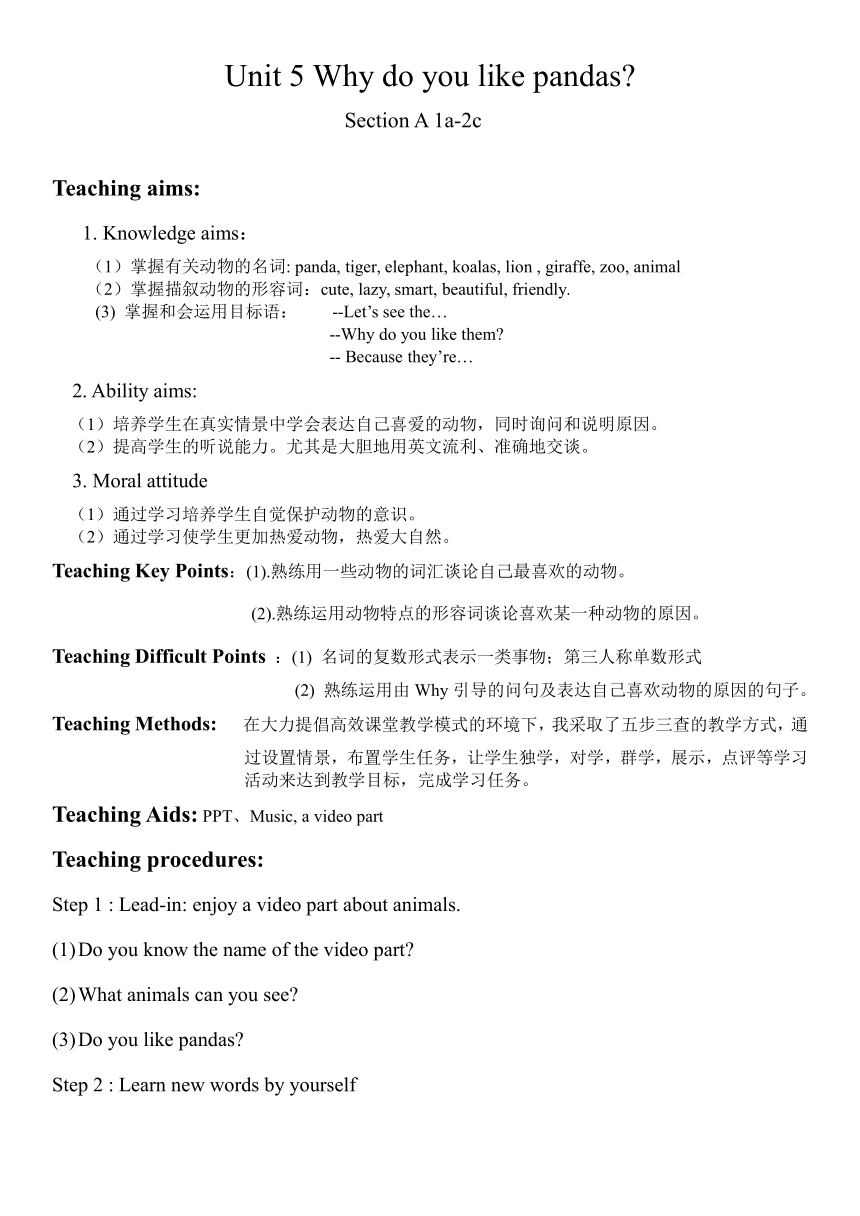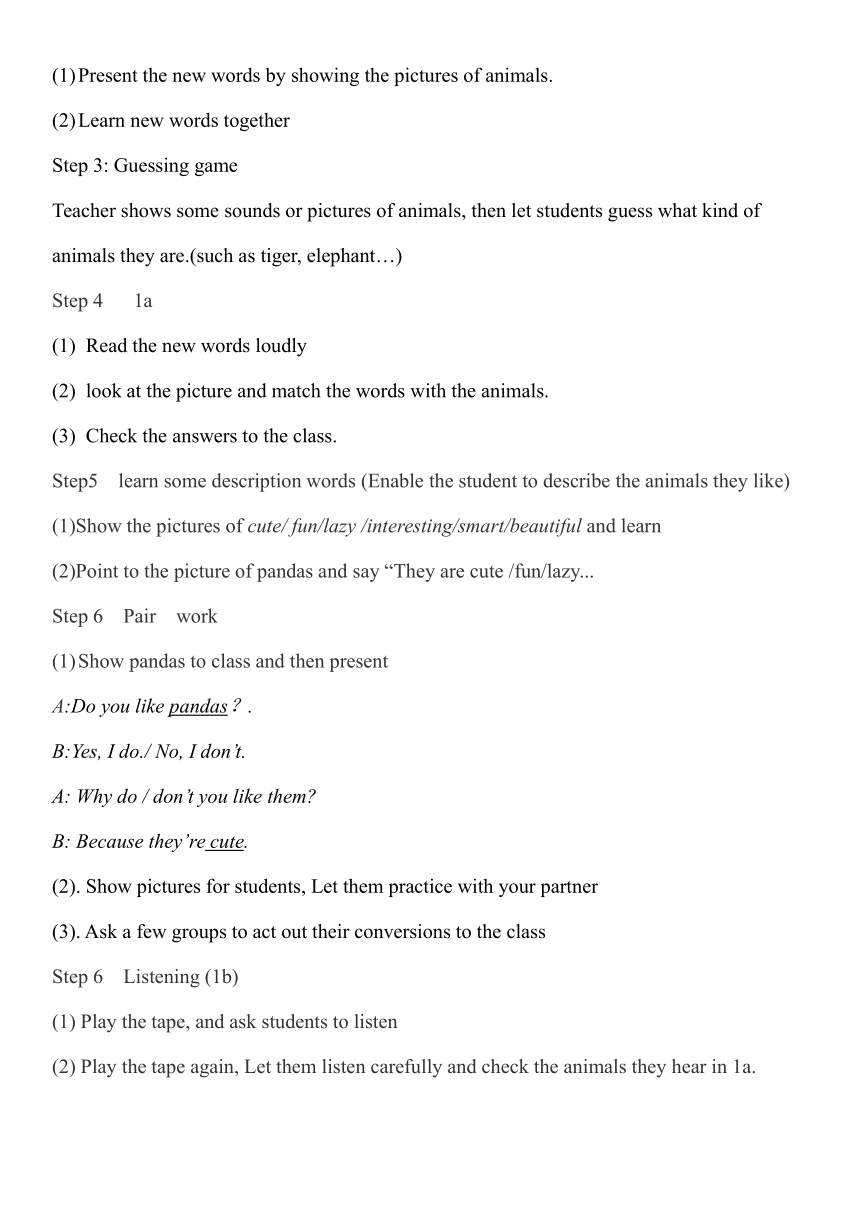Unit 5 What were you doing when the rainstorm came? Section A 1a 2c教案
文档属性
| 名称 | Unit 5 What were you doing when the rainstorm came? Section A 1a 2c教案 |  | |
| 格式 | docx | ||
| 文件大小 | 19.8KB | ||
| 资源类型 | 教案 | ||
| 版本资源 | 人教新目标(Go for it)版 | ||
| 科目 | 英语 | ||
| 更新时间 | 2022-03-20 11:44:59 | ||
图片预览


文档简介
Unit 5 Why do you like pandas
Section A 1a-2c
Teaching aims:
1. Knowledge aims:
(1)掌握有关动物的名词: panda, tiger, elephant, koalas, lion , giraffe, zoo, animal
(2)掌握描叙动物的形容词:cute, lazy, smart, beautiful, friendly.
(3) 掌握和会运用目标语: --Let’s see the…
--Why do you like them
-- Because they’re…
2. Ability aims:
(1)培养学生在真实情景中学会表达自己喜爱的动物,同时询问和说明原因。
(2)提高学生的听说能力。尤其是大胆地用英文流利、准确地交谈。
3. Moral attitude
(1)通过学习培养学生自觉保护动物的意识。
(2)通过学习使学生更加热爱动物,热爱大自然。
Teaching Key Points:(1).熟练用一些动物的词汇谈论自己最喜欢的动物。
(2).熟练运用动物特点的形容词谈论喜欢某一种动物的原因。
Teaching Difficult Points :(1) 名词的复数形式表示一类事物;第三人称单数形式
(2) 熟练运用由Why引导的问句及表达自己喜欢动物的原因的句子。
Teaching Methods: 在大力提倡高效课堂教学模式的环境下,我采取了五步三查的教学方式,通过设置情景,布置学生任务,让学生独学,对学,群学,展示,点评等学习活动来达到教学目标,完成学习任务。
Teaching Aids: PPT、Music, a video part
Teaching procedures:
Step 1 : Lead-in: enjoy a video part about animals.
Do you know the name of the video part
What animals can you see
Do you like pandas
Step 2 : Learn new words by yourself
Present the new words by showing the pictures of animals.
Learn new words together
Step 3: Guessing game
Teacher shows some sounds or pictures of animals, then let students guess what kind of animals they are.(such as tiger, elephant…)
Step 4 1a
Read the new words loudly
look at the picture and match the words with the animals.
Check the answers to the class.
Step5 learn some description words (Enable the student to describe the animals they like)
Show the pictures of cute/ fun/lazy /interesting/smart/beautiful and learn
Point to the picture of pandas and say “They are cute /fun/lazy...
Step 6 Pair work
Show pandas to class and then present
A:Do you like pandas?.
B:Yes, I do./ No, I don’t.
A: Why do / don’t you like them
B: Because they’re cute.
(2). Show pictures for students, Let them practice with your partner
(3). Ask a few groups to act out their conversions to the class
Step 6 Listening (1b)
(1) Play the tape, and ask students to listen
(2) Play the tape again, Let them listen carefully and check the animals they hear in 1a.
Step 7 Pair work
Show lions to class and then present
A:Let’s see the lions first?.
B: Why do you want to see them
A: Because they’re interesting.
(2). Show pictures for students, Let them practice with your partner
(3). Ask a few groups to act out their conversions to the class
Step 8 Listening (2a,2b)
Deal with some new words: Australia, Africa, South, kind of, be from
Play the tape, and ask students to listen
Play the tape again, Let them listen carefully and check the answers in class.
Step 9 Free talk
What’s your favorite animal Why
How about your partner Why
Step 10 Have a summary
(1). Words: tiger elephant koala panda lion giraffe
cute interesting lazy beautiful smart
(2). Drills: A: Let’s see the pandas first.
B: Why do you want to see the pandas
A: Because they are cute.
(3). Love animals, love ourselves.
Homework:
Search(收集) the pictures of the animals you like and describe(描述) them.
Do a survey and tell us what animals your parents like and why.
Blackboard design:
Unit 5 Why do you like pandas
Section A 1a-2c
tiger
lion cute
animal elephant friendly A: Let’s see the pandas first
giraffe be + beautiful. B:Why do you want to see the pandas
panda smart A: Because they’re cute.
koala lazy
be+adj.
Teaching reflection:
本单元的中心话题是描述动物以及对他们说的喜好和喜好的原因。本堂课由观看一个有趣的video引出动物话题,并以free talk的形式与学生进行交流,引导学生用英语说出自己在视频中所看到的动物。这一环节有助于吸引学生注意力,任务难度低,学生参与度高,也有助于学生自信心的培养和活跃课堂气氛。以问题:Where can we see animals 引入新课,再以脑力风暴和思维导图的形式引导学生说出各种各样的动物,很好地延续了学生的兴趣和注意力。通过问题What do you think of the animals 的设置学习和拓展描述性形容词,然后通过设计动物园中的一个真实情景,展开对话,呈现新句型:What animals do you like 和Why do you like them 以词汇带动句型,化零为整,深入浅出。游戏巩固词汇和句型,是本课时的高潮部分。很好地激发了学生说英语的欲望,打开了学生的视野和思维,任务的设计容易操作,由于所谈论的人物是学生最熟悉的和喜欢的,使学生对英语的学习充满了信心。同时又能够继续熟悉和训练本课时前面部分提到过的句型和词汇。最后展示人和动物和谐相处的图片,升华和激发学生保护野生动物的情感。课堂跌宕起伏,收放自如,寓教于乐,令人回味,为本单元后面的学习奠定了坚实的基础。
本节课总体情况是很满意的,达到了调动学生兴趣,以及渗透学习策略和小组合作学习的计划。当然也有一些不足之处:在小组合作过程中,有个别学生不够积极参与,趁机讲话;
教学建议:对于优秀的学生,老师只讲授书本的知识还远远不够,因此在全面整合书本内容的同时,要求老师要在课堂上补充及丰富教材;对于基础较差的学生,教师更要特别了解他们对于新知识掌握的情况,多设计一些能有助于他们理解和记忆的教学活动,只有这样,教师才能兼顾到班级的各个层次的学生,使所有的学生都能学有所得。同时,我们认为死板地跟着教材步骤教学的方式是不可取的,学生所学的知识零散,容易忘记,也不会灵活运用。采用了小组合作学习的模式,教师容易对于小组中的个别学困生有所忽视而导致出现了个别学生开小差的现象。所以教师在设计小组活动任务时,尽量每一个小组成员都有事可做,使所有学生都可以参与到小组活动中来。
Section A 1a-2c
Teaching aims:
1. Knowledge aims:
(1)掌握有关动物的名词: panda, tiger, elephant, koalas, lion , giraffe, zoo, animal
(2)掌握描叙动物的形容词:cute, lazy, smart, beautiful, friendly.
(3) 掌握和会运用目标语: --Let’s see the…
--Why do you like them
-- Because they’re…
2. Ability aims:
(1)培养学生在真实情景中学会表达自己喜爱的动物,同时询问和说明原因。
(2)提高学生的听说能力。尤其是大胆地用英文流利、准确地交谈。
3. Moral attitude
(1)通过学习培养学生自觉保护动物的意识。
(2)通过学习使学生更加热爱动物,热爱大自然。
Teaching Key Points:(1).熟练用一些动物的词汇谈论自己最喜欢的动物。
(2).熟练运用动物特点的形容词谈论喜欢某一种动物的原因。
Teaching Difficult Points :(1) 名词的复数形式表示一类事物;第三人称单数形式
(2) 熟练运用由Why引导的问句及表达自己喜欢动物的原因的句子。
Teaching Methods: 在大力提倡高效课堂教学模式的环境下,我采取了五步三查的教学方式,通过设置情景,布置学生任务,让学生独学,对学,群学,展示,点评等学习活动来达到教学目标,完成学习任务。
Teaching Aids: PPT、Music, a video part
Teaching procedures:
Step 1 : Lead-in: enjoy a video part about animals.
Do you know the name of the video part
What animals can you see
Do you like pandas
Step 2 : Learn new words by yourself
Present the new words by showing the pictures of animals.
Learn new words together
Step 3: Guessing game
Teacher shows some sounds or pictures of animals, then let students guess what kind of animals they are.(such as tiger, elephant…)
Step 4 1a
Read the new words loudly
look at the picture and match the words with the animals.
Check the answers to the class.
Step5 learn some description words (Enable the student to describe the animals they like)
Show the pictures of cute/ fun/lazy /interesting/smart/beautiful and learn
Point to the picture of pandas and say “They are cute /fun/lazy...
Step 6 Pair work
Show pandas to class and then present
A:Do you like pandas?.
B:Yes, I do./ No, I don’t.
A: Why do / don’t you like them
B: Because they’re cute.
(2). Show pictures for students, Let them practice with your partner
(3). Ask a few groups to act out their conversions to the class
Step 6 Listening (1b)
(1) Play the tape, and ask students to listen
(2) Play the tape again, Let them listen carefully and check the animals they hear in 1a.
Step 7 Pair work
Show lions to class and then present
A:Let’s see the lions first?.
B: Why do you want to see them
A: Because they’re interesting.
(2). Show pictures for students, Let them practice with your partner
(3). Ask a few groups to act out their conversions to the class
Step 8 Listening (2a,2b)
Deal with some new words: Australia, Africa, South, kind of, be from
Play the tape, and ask students to listen
Play the tape again, Let them listen carefully and check the answers in class.
Step 9 Free talk
What’s your favorite animal Why
How about your partner Why
Step 10 Have a summary
(1). Words: tiger elephant koala panda lion giraffe
cute interesting lazy beautiful smart
(2). Drills: A: Let’s see the pandas first.
B: Why do you want to see the pandas
A: Because they are cute.
(3). Love animals, love ourselves.
Homework:
Search(收集) the pictures of the animals you like and describe(描述) them.
Do a survey and tell us what animals your parents like and why.
Blackboard design:
Unit 5 Why do you like pandas
Section A 1a-2c
tiger
lion cute
animal elephant friendly A: Let’s see the pandas first
giraffe be + beautiful. B:Why do you want to see the pandas
panda smart A: Because they’re cute.
koala lazy
be+adj.
Teaching reflection:
本单元的中心话题是描述动物以及对他们说的喜好和喜好的原因。本堂课由观看一个有趣的video引出动物话题,并以free talk的形式与学生进行交流,引导学生用英语说出自己在视频中所看到的动物。这一环节有助于吸引学生注意力,任务难度低,学生参与度高,也有助于学生自信心的培养和活跃课堂气氛。以问题:Where can we see animals 引入新课,再以脑力风暴和思维导图的形式引导学生说出各种各样的动物,很好地延续了学生的兴趣和注意力。通过问题What do you think of the animals 的设置学习和拓展描述性形容词,然后通过设计动物园中的一个真实情景,展开对话,呈现新句型:What animals do you like 和Why do you like them 以词汇带动句型,化零为整,深入浅出。游戏巩固词汇和句型,是本课时的高潮部分。很好地激发了学生说英语的欲望,打开了学生的视野和思维,任务的设计容易操作,由于所谈论的人物是学生最熟悉的和喜欢的,使学生对英语的学习充满了信心。同时又能够继续熟悉和训练本课时前面部分提到过的句型和词汇。最后展示人和动物和谐相处的图片,升华和激发学生保护野生动物的情感。课堂跌宕起伏,收放自如,寓教于乐,令人回味,为本单元后面的学习奠定了坚实的基础。
本节课总体情况是很满意的,达到了调动学生兴趣,以及渗透学习策略和小组合作学习的计划。当然也有一些不足之处:在小组合作过程中,有个别学生不够积极参与,趁机讲话;
教学建议:对于优秀的学生,老师只讲授书本的知识还远远不够,因此在全面整合书本内容的同时,要求老师要在课堂上补充及丰富教材;对于基础较差的学生,教师更要特别了解他们对于新知识掌握的情况,多设计一些能有助于他们理解和记忆的教学活动,只有这样,教师才能兼顾到班级的各个层次的学生,使所有的学生都能学有所得。同时,我们认为死板地跟着教材步骤教学的方式是不可取的,学生所学的知识零散,容易忘记,也不会灵活运用。采用了小组合作学习的模式,教师容易对于小组中的个别学困生有所忽视而导致出现了个别学生开小差的现象。所以教师在设计小组活动任务时,尽量每一个小组成员都有事可做,使所有学生都可以参与到小组活动中来。
同课章节目录
- Unit 1 What's the matter?
- Section A
- Section B
- Unit 2 I'll help to clean up the city parks.
- Section A
- Section B
- Unit 3 Could you please clean your room?
- Section A
- Section B
- Unit 4 Why don't you talk to your parents?
- Section A
- Section B
- Unit 5 What were you doing when the rainstorm came
- Section A
- Section B
- Review of Units 1-5
- Unit 6 An old man tried to move the mountains.
- Section A
- Section B
- Unit 7 What's the highest mountain in the world?
- Section A
- Section B
- Unit 8 Have you read Treasure Island yet?
- Section A
- Section B
- Unit 9 Have you ever been to a museum?
- Section A
- Section B
- Unit 10 I've had this bike for three years.
- Section A
- Section B
